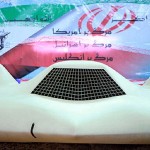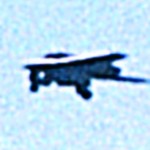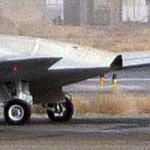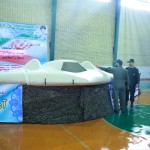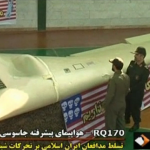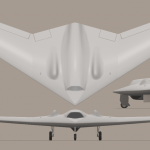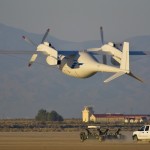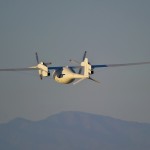
For something that we’re not necessarily supposed to know much about, the RQ-170 has gotten a ton of headlines.
It is the drone that was captured by Iran in December 2011. While U.S. defense department officials stalled in their response, the government eventually admitted to “losing” an RQ-170 in the same region as Iran claimed to have captured one, virtually in tact.
We know one thing for sure about the “Sentinel” unmanned aerial drone, the U.S. government says it was used in gather intelligence before the raid that killed Osama bin Laden in May 2011. In an article describing the little-known “National Geospatial-Intelligence Agency,” The Atlantic reported that the agency analyzed data “from a sophisticated next-generation drone that kept watch on the compound before, during, and after the raid. The drone was an RQ-170 built by Lockheed Martin.”
Officially, according to the U.S. Air Force factsheet, the RQ-170 “is a low observable unmanned aircraft system (UAS) being developed, tested and fielded by the Air Force.” Its mission is to “provide surveillance and reconnaissance to locate targets.”
The Air Force acknowledges only that the RQ-170 is flown by the 432nd Wing at Creech Air Force Base, Nev., and the 30th Reconnaissance Squadron at Tonopah Test Range, Nev. Tonopah was the home of the F-117 stealth attack jet when its very existence was secret. Lockheed Martin’s Skunk Works, the same outfit that built the F-117, also developed the “Sentinel.”
In fact, the 30th Squadron is a unit of the 432nd Operations Group under the 432nd Air Expeditionary Wing.
The 432nd Wing has flown the “Sentinel” since 2007. The Air Force has not updated its factsheet since December 2010, but a lot has happened since then.
The U.S. has not released any official photos of the tailless flying wing. A drone was sighted at Kandahar International Airport in late 2007, which the Air Force confirmed was a RQ-170.
In the months prior to Iran’s capture of an RQ-170, as reported by the New York Times, the drone was used to conduct flights over Iran as “part of an increasingly aggressive intelligence collection program,” possibly to keep tabs on its nuclear ambitions.

On Dec. 4, 2011, Iran claimed its Army electronic warfare unit downed a drone that had violated its airspace along the eastern border. The U.S. claimed the drone was flying over western Afghanistan when contact was lost. The U.S. changed its course the next day, admitting that the drone was being used by the Central Intelligence Agency to conduct secret missions.
Iran released footage of a mostly in-tact RQ-170 on Dec. 8. Defense analysts, looking at the barely damaged aircraft, concluded that it had not suffered engine failure or been shot down by a missile or small arms fire. This left open the possibility that Iran was able to hack the controls and electronically capture the RQ-170.
“Either this was a cyber/electronic warfare attack system that brought the system down or it was a glitch in the command-and-control system,” said Dan Goure, an analyst at the Lexington Institute in Arlington, Va., in an Air Force Times interview.
Goure compared the capture to the Soviet Union’s downing of a U2 spy plane in 1960.
Subterfuge?
Most surprising was the fact that the CIA-operated drone was not equipped with a self-destruct device. From a technology standpoint, it is slightly less likely, however, that the CIA believed the stealth drone could not be hacked or electronically captured by Iran as it is that the CIA simply allowed a Trojan horse to be dropped on its adversary. The west has long had an electronic advantage over Iran, and Iranian computers have been utterly bullied by hackers for years.
In May 2012, Russian computer security firm Kaspersky Lab claimed that the Flame virus, which wreaked havoc on Iranian and other countries’ computer systems, issued a claim that the virus was part of an Israeli campaign of cyber warfare against Iran, perhaps its biggest enemy and threat. Israel, a close American ally, has been successful in the past, with experts stating that the Stuxnet computer worm causing 20 percent of Iran’s nuclear centrifuges to spin out of control until they self-destructed, was a similar attack. Stuxnet was one in a series of setbacks for Iran’s nuclear program going back to the 1990s.
There is no official information available about what, if anything, Iran learned from the RQ-170. Russian and Chinese officials have also visited Iran to look the drone over.
Specifications
General
Crew: Unmanned
Length: 14-15 ft (estimated)
Wingsman: 39-40 ft (estimated) (Aviation Week estimated 65 feet in 2009)
Height: 6 ft (estimated)
Empty weight: Unknown
Engine: Unknown
Performance
No data available.
Armament
None.
Air Cache submitted, on July 16, 2012, a request under the Freedom of Information Act for information, specifications, and official photographs of the RQ-170. The request was denied, citing the classified status of the project.
Essential Reading
Online Resources:
- U.S. Air Force Official Factsheet
- Wikipedia — Not recommended as a primary source due to the controversy surrounding the program
- Aviation Week — First reporting of the RQ-170’s existence in 2009
